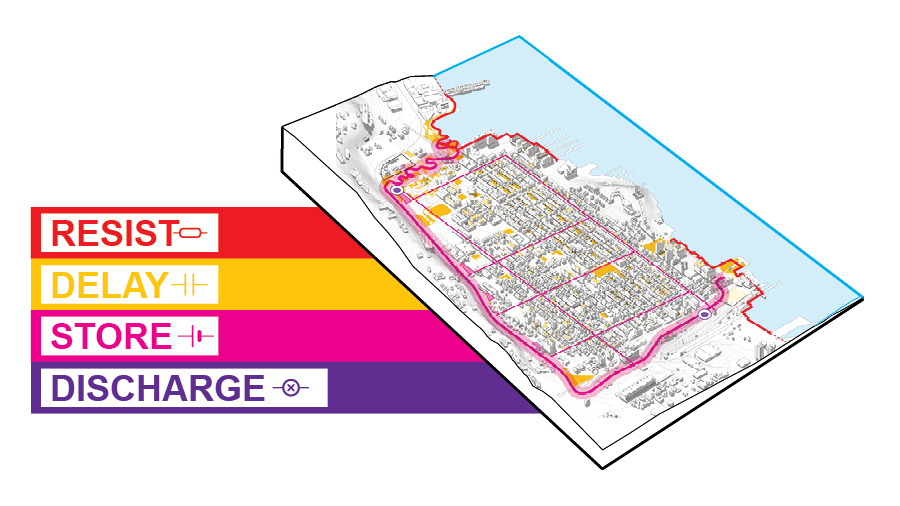
PROJECT PAGES: Hudson River Project: Resist, Delay, Store, Discharge
BACKGROUND
Developed by: OMA with Royal HaskoningDHV; Balmori Associates; and HR&A Advisors
Hoboken is the fourth densest city in the U.S. Once a blue collar industrial and manufacturing city, it is becoming a bedroom community of New York City’s central business districts. Since large parts of Hoboken were once marshland and a filled-in island, the city is susceptible to flash floods and storm surges, even from minor storms. Hurricane Sandy flooded much of the city, disrupting the primary transit hub for over 50,000 people.
Location: Hoboken, Weehawken, Jersey City, NJ
Award: $230 Million
Implemented By: New Jersey Department of Environmental Protection and City of Hoboken
PROPOSAL
This project is a multifaceted approach to managing stormwater from flooding and surge along the Hudson River. It explores using hard infrastructure and soft landscape—including permeable paving, rain gardens, and rainwater storage—for coastal defense.
The project’s comprehensive approach has four integrated components:
Resist: a combination of hard infrastructure (such as bulkheads, floodwalls and seawalls) and soft landscaping features (such as berms and/or levees which could be used as parks) that will act as barriers along the coast during exceptionally high tides and/or storm surge events. These measures are focused at the two main breach points of water during Hurricane Sandy.
Delay: urban green infrastructure designed to focus on slowing stormwater runoff throughout the region using a combination of public and private amenities.
Store: green and grey infrastructure improvements, such as bio-retention basins, swales, and green roofs, intended to slow down and capture stormwater, and complement the City of Hoboken’s existing Green Infrastructure Strategic Plan.
Discharge: enhancements to Hoboken’s existing stormwater management system to reduce combined sewage overflow and manage flooding.
View the team’s full original proposal here.
IMPLEMENTATION PROGRESS
The project has been rebranded as the “Hudson River” project that comprises the four Resist, Delay, Store, Discharge components. The $230 million in federal funding provides for the “Resist” project, which will be led by the New Jersey Department of Environmental Protection, while the City of Hoboken spearheads the Delay, Store, and Discharge interventions. The project broke ground in May 2021.
The first phase of the project, Sewer System Modification (SSM), was mostly completed by July 2022. SSM will prevent storm surge from overwhelming the combined sewers and subverting the protection generated by the Resist floodwall by separating portions of Hoboken’s combined sewer system (CSO). Phase two of the project, the Resist segment, will extend from Jersey City to Weehawken and consist of an 8,846-foot series of hard infrastructure measures like floodwalls and deployable gates as well as soft landscaping elements like berms. Construction will begin in early 2023.
Parallel to that work, the City of Hoboken is building a series of interconnected resiliency parks to capture, store, and convey stormwater. This includes an expansion of Southwest Resiliency Park and the development of Northwest Resiliency Park, which will have the capacity to store and filter one million gallons of stormwater and is slated for completion by April 2023. Finally, the project received an additional $100 million from the State for above-ground flood mitigation infrastructure at the new three-acre Harborside Park, which will begin construction by spring 2023.
Check out the project website here.
Budget: $480 million ($230M CDBG-DR grant through Rebuild by Design, $150M in City funding through the Open Space Trust Fund and low interest loans from the New Jersey Infrastructure Bank, $100M from the State of New Jersey)
Press:
- Rebuild By Design: Harborside Park Construction To Begin In 2023, Hoboken Says, TAPintoHoboken (Aug 2022)
- NJ Budget Allocates $100M To Rebuild By Design Project, TAPintoHoboken (July 2022)
- 8 Years After Sandy, $230M Hoboken Flood Plan Gets Kickoff, NBC (May 2021)
